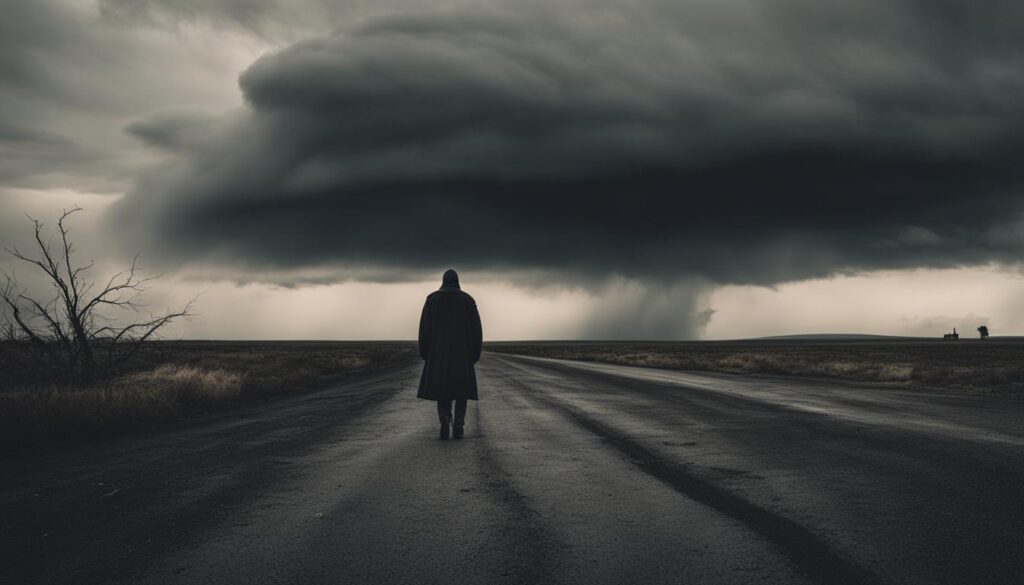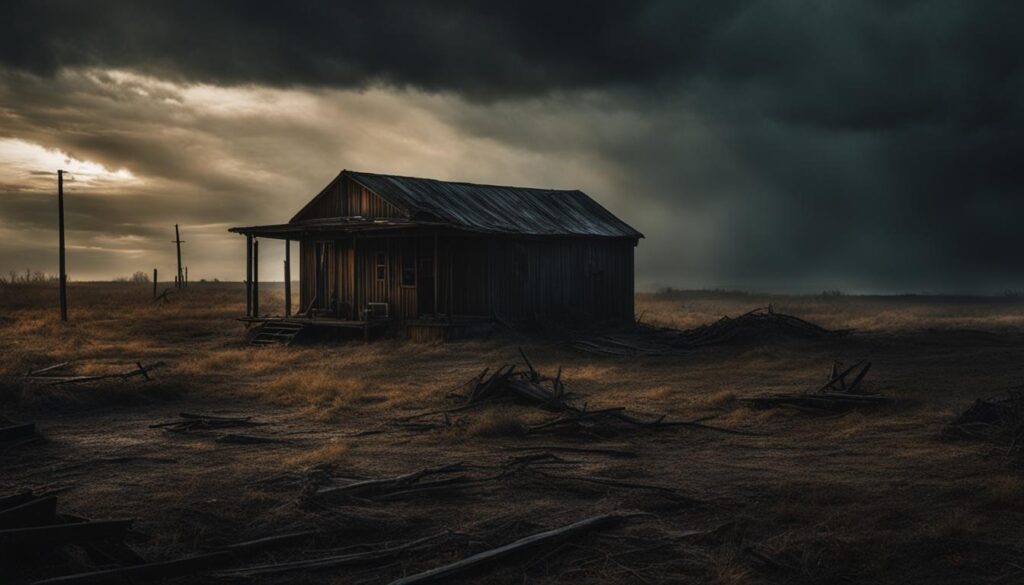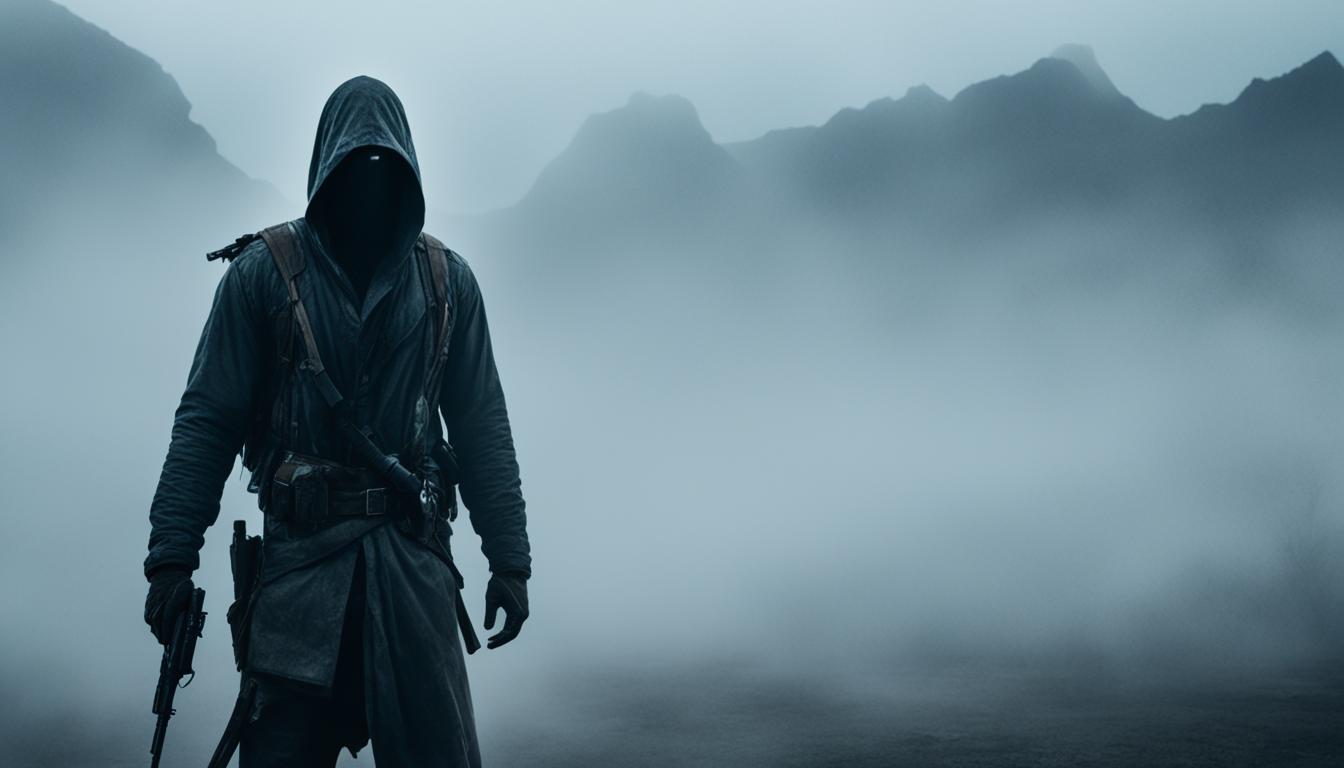Stephen King’s post-apocalyptic epic, “The Stand,” has captivated readers for decades, and now, it has been brought to life on the big screen. The film adaptation portrays a ravaged world, brought to its knees by a deadly virus that has wiped out most of civilization. Amidst the chaos, a battle of good versus evil ensues, as the remaining survivors must choose between darkness and light.
Join us as we explore “The Stand” film adaptation and its take on the timeless struggle between good and evil.
Key Takeaways:
- The Stand is an adaptation of Stephen King’s post-apocalyptic epic novel about a battle between good and evil in a world devastated by a deadly virus.
- The film explores the central theme of good versus evil through its portrayal of characters facing extreme adversity.
- Through examining the casting, direction, and cinematography, we can gain insight into how the filmmakers brought this epic story to life on the big screen.
- The critical reception and audience response to “The Stand” film adaptation can help us understand its impact on popular culture.
- By exploring the legacy and influence of “The Stand,” we can gain a greater appreciation for its significance in the genre of apocalyptic films.
Stephen King’s Epic Novel “The Stand”
“The Stand” is an epic novel written by legendary author Stephen King. First published in 1978, the novel has captivated readers for decades with its powerful storytelling and apocalyptic themes.
The novel tells the story of a deadly virus that wipes out most of the world’s population, leaving survivors to navigate a post-apocalyptic wasteland. The novel’s central theme revolves around the battle of good versus evil, as a group of survivors must band together to face a looming threat.
King’s masterful character development brings the survivors to life, each with their unique motivations and struggles. The novel’s diverse cast of characters includes a former convict, a deaf-mute, a pregnant woman, and a retired sociology professor, among others.
The novel has left a lasting impact on the literary world, with many considering it to be among King’s most influential works. It has also gone on to inspire other works within the genre of apocalyptic fiction.
The Storyline of the Film Adaptation
“The Stand” film adaptation tells the story of a world devastated by a deadly virus that wiped out 99% of the population. In this post-apocalyptic setting, the remaining survivors are forced to choose between joining the forces of good or evil in an ultimate battle for the fate of humanity.
The main character, Stu Redman, is immune to the virus and finds himself at the center of the battle between the two sides. Alongside fellow survivors, including Mother Abagail and Larry Underwood, Stu must navigate a dangerous and unstable world to ultimately stand against Randall Flagg, a charismatic and manipulative figure who represents the embodiment of evil.
The film adaptation portrays the vivid imagery of King’s epic novel, depicting a world scarred by destruction and chaos. The journey of the main characters is filled with peril and obstacles at every turn, making for a thrilling and suspenseful viewing experience.

The film adaptation brings to life the battle of good versus evil in a gripping and visually stunning manner, making it a must-see for fans of Stephen King’s work and post-apocalyptic films.
Casting and Character Development
In “The Stand” film adaptation, the casting choices were pivotal in bringing the beloved characters from Stephen King’s novel to life on screen. With a talented ensemble cast, the film effectively captures the unique personalities and motivations behind each character.
The character development in the film is a highlight, as the audience witnesses the evolution of each character throughout the narrative. From the hardened survivor Stu Redman, played by James Marsden, to the enigmatic and dangerous Randall Flagg, portrayed by Alexander Skarsgård, the characters’ growth and struggles are central to the film’s storyline.
Standout performances also include Whoopi Goldberg as the spiritual Mother Abagail and Owen Teague as the conflicted Harold Lauder. Through their nuanced performances, these actors skillfully convey the complex emotions and motivations of their characters.
The Impact of Casting
The casting choices for “The Stand” film adaptation were instrumental in bringing the characters to life in a way that stayed true to Stephen King’s vision. Through the skillful performances of the cast, the audience is able to connect with each character on a deeper level, investing in their personal journeys throughout the narrative.
The Significance of Character Development
The character development in “The Stand” film adaptation is crucial in conveying the themes of good versus evil and the struggle for survival in a post-apocalyptic world. By showing the growth and evolution of each character, the film effectively portrays the hardships they face and the choices they must make to survive.
The Direction and Cinematography
One of the most striking elements of “The Stand” film adaptation is its direction and cinematography. Director Mick Garris masterfully captures the post-apocalyptic world, using visual storytelling techniques to immerse the audience in a bleak, desolate landscape.

Through the use of lighting, camera angles, and set design, Garris creates an atmosphere of tension and suspense, particularly in key moments of the film. For example, the showdown between the forces of good and evil is visually striking, with the use of contrasting colors and shadows adding to the drama of the scene.
The cinematography in “The Stand” is equally impressive. Scenes are shot with a deliberate pace, allowing the audience to fully absorb the details of the ravaged world and the characters’ struggles within it. Close-ups on characters’ faces emphasize their emotions and motivations, while wide shots capture the vastness and emptiness of the landscape.
Overall, the direction and cinematography of “The Stand” adds an extra layer of depth to the film adaptation, elevating it beyond a simple retelling of Stephen King’s novel and making it a visually stunning piece of cinema in its own right.
Exploring the Themes of Good vs. Evil
The battle of good versus evil is a central theme in “The Stand” film adaptation. Throughout the story, characters are faced with difficult choices and struggles as they navigate a world ravaged by a deadly virus. At its core, the film explores the age-old question of whether humans are inherently good or evil.
The main characters in “The Stand” represent both sides of this dichotomy, with some choosing to act in the interest of others and the greater good, while others prioritize their own personal gain and desires. The film showcases the consequences of these choices and how they ultimately determine the fate of humanity.
As the story progresses, the battle between good and evil becomes increasingly complex, blurring the lines between the two. The film highlights the importance of making the right choices even in the face of adversity and how those choices can ultimately shape the world we live in.
Comparisons to the Novel
As with any film adaptation, there are bound to be differences between the screenplay and its source material. “The Stand” film adaptation is no exception. While the overall story arc remains intact, there are notable changes to be found.
Firstly, some of the characters’ storylines are altered or condensed in the film to fit within its runtime. The inclusion of new characters and the omission of others also changes the dynamic of the narrative. Notably, the character of Trashcan Man has a much smaller role in the film than in the novel.
Additionally, some of the major plot points in the novel are altered or removed entirely in the film. For example, the finale of the film is significantly different from that of the novel. These changes, while perhaps disappointing to some fans of the book, allow the film to tell its own story and stand on its own merits.
Despite these differences, the film is a faithful adaptation of the novel in terms of its overall themes and characterizations. The battle of good versus evil is still the driving force of the story, and the post-apocalyptic world is just as bleak and terrifying as it is on the page.
Overall, “The Stand” film adaptation is a well-crafted and entertaining depiction of Stephen King’s epic novel, even with the changes made in the adaptation process.
Critical Reception and Audience Response
Upon its release, “The Stand” film adaptation was met with mixed critical reception. While some praised the film’s epic scope and impressive visuals, others criticized its pacing and deviations from the source material.
Despite this, the film has garnered a dedicated fan base and is widely regarded as a cult classic among fans of Stephen King’s work.
Many fans appreciate the film’s commitment to exploring the novel’s central themes, particularly the battle of good versus evil. The film’s haunting post-apocalyptic world has also left a lasting impression on viewers.
Overall, “The Stand” film adaptation has received a mixed critical reception but has undoubtedly left a lasting impact on audiences and the genre of apocalyptic films.
Legacy and Influence of “The Stand” Film Adaptation
Since its release, “The Stand” film adaptation has left an indelible mark on popular culture. With a devoted fanbase, the film has become a cult classic and a staple of the apocalyptic genre. Its legacy continues to thrive today, with the recent release of a new adaptation.
The film’s influence can also be seen in other works of art, from television shows to literature. It has inspired countless creators to delve into the world of post-apocalyptic storytelling, exploring themes of survival and the battle between good and evil.
As a film adaptation, “The Stand” has set a high standard for how to successfully bring a beloved novel to the big screen. It has influenced the way audiences interpret adaptations and has paved the way for future adaptations to come.
The legacy and influence of “The Stand” film adaptation cannot be overstated. It serves as a testament to the power of storytelling and the enduring impact of a great film.
FAQ
What is "The Stand" Stephen King film adaptation about?
“The Stand” Stephen King film adaptation is based on a post-apocalyptic world where humanity is ravaged by a deadly virus. It explores the battle between good and evil as the remaining survivors struggle to rebuild society.
Is "The Stand" a film adaptation of a novel?
Yes, “The Stand” is a film adaptation of Stephen King’s epic novel of the same name. The film takes inspiration from the plot, characters, and overall themes of the novel.
How does the film adaptation portray the post-apocalyptic world?
The film adaptation of “The Stand” depicts a bleak and ravaged post-apocalyptic world. It showcases the devastation caused by the deadly virus and the challenges faced by the survivors as they navigate this new reality.
Who are the main characters in "The Stand" film adaptation?
“The Stand” film adaptation features a diverse ensemble of characters, each with their unique struggles and motivations. Some key characters include Stu Redman, Fran Goldsmith, Randall Flagg, and Mother Abagail.
How does "The Stand" film adaptation explore the theme of good versus evil?
“The Stand” film adaptation delves deeply into the theme of good versus evil. It examines the choices the characters must make and the moral dilemmas they face as they confront the forces of darkness in the post-apocalyptic world.
Are there any notable differences between the film adaptation and the novel?
Yes, there are some differences between the film adaptation of “The Stand” and Stephen King’s novel. While the film stays true to the overall narrative, there may be some changes and alterations made to better suit the medium of film.
How has "The Stand" film adaptation been received by critics?
“The Stand” film adaptation has received mixed reviews from critics. While some praised its faithful adaptation and powerful performances, others felt that certain elements did not live up to the expectations set by the novel.
What is the legacy and influence of "The Stand" film adaptation?
“The Stand” film adaptation has left a lasting impact on the genre of apocalyptic films. It has influenced future filmmakers and storytellers, and its themes of survival, good versus evil, and the resilience of humanity continue to resonate with audiences.



